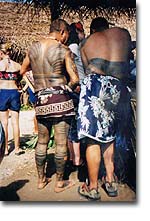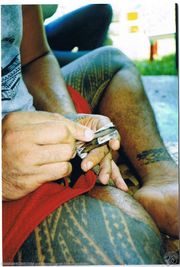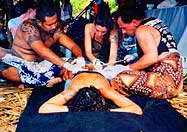Au
A group of islands in the Southern Pacific Ocean.
It was in Tonga and Samoa that the Polynesian tattoo developed into a highly refined art. In ancient Samoa, religious ritual and warfare were the popular pastimes, and tattooing played an important role in both. The tattoo artist held a hereditary and highly privileged position. He customarily tattooed young men in groups of six to eight during a ceremony attended by friends and relatives who participated in special prayers and celebrations associated with the tattooing ritual. The Samoan warrior's tattoo began at the waist and extended to just below the knee. Samoan women were tattooed as well, but female tattooing was limited to a series of delicate flower-like geometrical patterns on the hands and the lower part of the body.
Contents
The Tattoo Process
Mistakenly called a Pe'a by Europeans. The Pe'a is actually the small triangle tattooed in the center of the lower back where the tattoo began.
The Aus are the Samoan equivalent of tattoo needle. They are fashioned from boars or sharks teeth, although legend has it that the bones of Chiefs were used. As with any tattoo process, there are multiple sizes and functions of the tool; Au Sogi, to make the wide lines, Au Fa'atala, used to tattoo points and dots, and Au Tapulu, to fill in large areas of color.
The lapalapa, a wooden rod used as a mallet, taps the Au into the skin, thus indelibly marking the subject.
The Ausolo are the assistants that work with the tattooist while receiving a traditional Samoan Tatau (Pe'a). There are often four assistants: two holding the person, one stretching the skin, and one wiping the blood away with a damp cloth.
The Pe'a is very painful takes days to do and to stop is to leave you with a Pe'a mutu, an incomplete tattoo that is a dishonor and brings shame. Once the Pe'a is complete the person may then eat and rejoice with the other men who wear this tattoo. Often people have died from blood loss or shock. Some fatalities have been recorded due to infection, blood loss, or both.
Samoan Tattoo Folktale
The tradition supposedly came from Tonga (Samoa's age old enemy) as two Samoan women were swimming back after gaining the knowledge of tattooing chanting- "Tattoo the women and not the men"- but then they spotted a giant clam and dived deep for it. After coming back up they were short of air and slightly light headed and got confused chanting- "Tattoo the men and not the women". (though it should be noted that women are tattooed, wearing with a light design of cross hatch)
Related Articles
BME Archives
- One girl's experience with Samoan Tattooing featured on ModBlog



